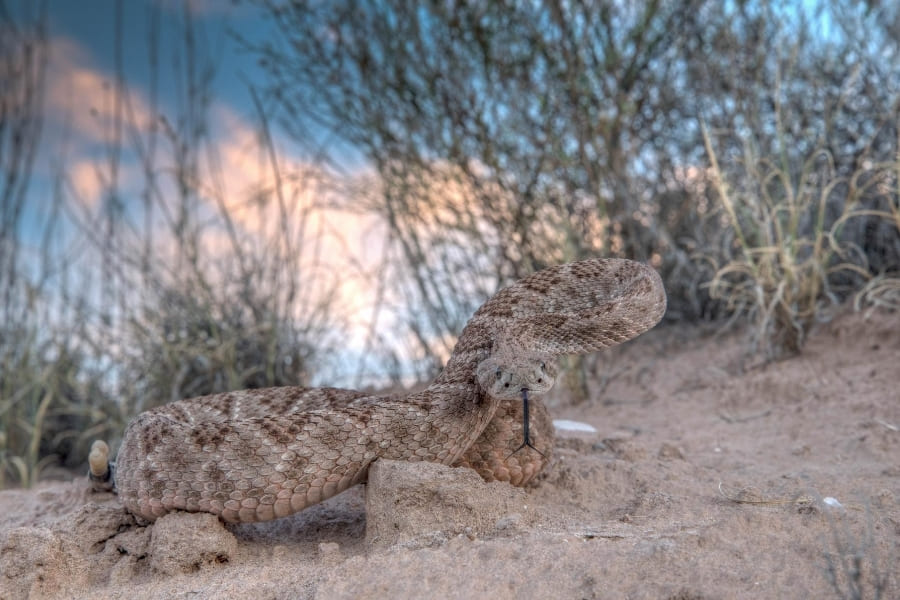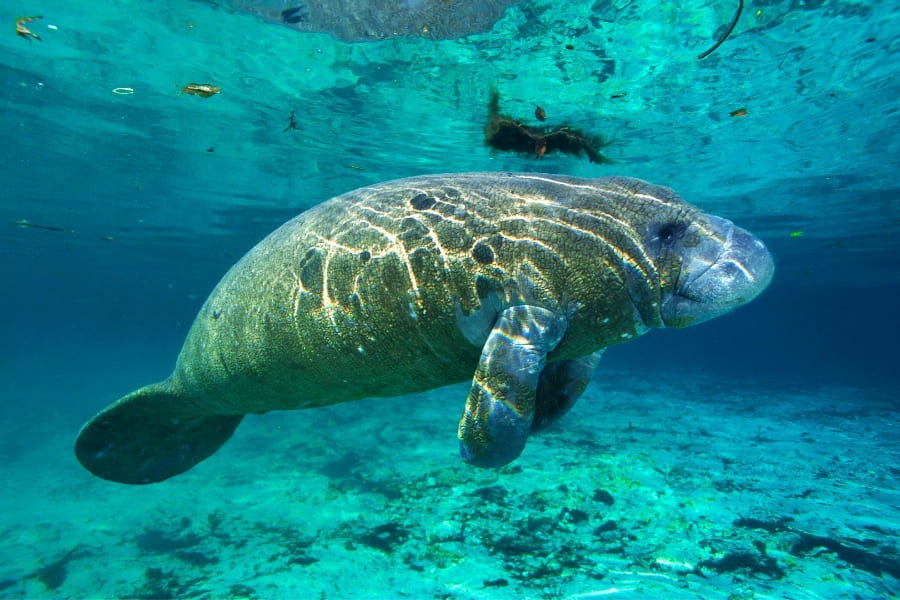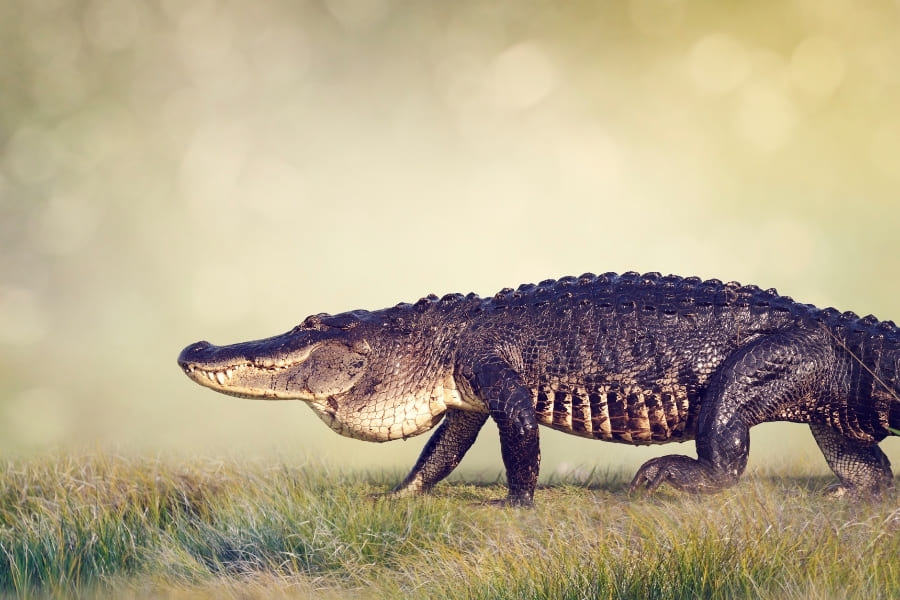With its warm climate and diverse habitats, Florida is a haven for animals. This diversity also includes snakes that can be found all over the state. The reptiles play an important role for the ecosystem – especially because they keep the rodent population in check and serve as food for other animals.
Due to ever increasing development, contact between humans and snakes cannot always be avoided. Most of the time, these encounters end without accident, as snakes are inherently shy and not aggressive. However, anyone who disturbs the animals accidentally or on purpose should expect a painful bite.
In this article, we will explain where Florida’s harmless and dangerous snake species live, and how to recognize them. You will also learn how to avoid encounters with snakes and which tips can save your life in the event of a snake bite.
Snakes in Florida – harmless Species
Of the 45 snake species in Florida, the majority are harmless to humans. Most tourists never even see a snake, as these animals lead well-hidden lives. Nevertheless, you may come across them on a hike or boat tour. Here are the most common harmless snake species in the Sunshine State:
Black racer
This snake ranks among the most common species in Florida. As the name suggests, it is characterized by black scales and high velocity. Black racers can reach a length of up to 6.2 ft and are often found in agrarian habitats such as farmland and gardens. For humans, this species is harmless. Farmers even welcome its presence, as the black racer feeds on small rodents.
Ring-necked snake
This snake can grow to a length of up to 1.2 feet and is easily recognized by her yellow ring behind the head. When she is playing dead, you can also see her yellowish underside. In Florida, this species is often found in piles of leaves, gardens or even in houses. Fortunately, the ring-necked snake is harmless to humans. She does not inject venom, but defends herself by secreting a foul smell.
Corn snake
Due to their striking black-red-brown coloration, corn snakes are often kept in terrariums. However, they also live in Florida´s natural habitats, where they skillfully climb trees. Sometimes, they enter houses and garages through small openings. Corn snakes can bite if they feel threatened. However, they are harmless to humans – unlike the coral snake (see below). Being similar in color, these two species are often confused.
Florida brown snake
With a length of only 1 ft, Florida brown snakes are among the smallest species in Florida. They feature a yellowish-brown coloration and are at home in forests, wetlands and farmland. Sometimes, they also populate gardens, where they find ideal hiding spots, or end up in swimming pools by accident. For humans and pets, this species is harmless.
Southern water snake
Due to its dark spots on light scales, this snake is often confused with the cottonmouth. In addition, both snakes share the same habitat: the banks of rivers and lakes, where they hunt frogs, fish and salamanders. However, the southern water snake is not venomous and poses no threat to humans. Even without venom, though, it can still bite. This snake also omits a foul smell – another reason not to disturb it.
Pythons
These imposing constrictors originally come from the Old World and are not native to Florida. However, many pythons were imported as pets and managed to escape. For some years now, they have been causing a veritable snake invasion, especially in the Everglades. Their population is estimated at over 100,000, and the state has even put a bounty on their heads – so far with little success.
Snakes in Florida – dangerous Species
Florida is home to 6 species of snakes that can be dangerous to humans. Even if the risk of a bite is low – it pays to know what these snakes look like and where they live:
Eastern diamondback rattlesnake
- Size: 3.9–7.9 ft
- Features: black, brown and yellowish-white patterns in diamond shape; tail rattle
- Habitat: oak and pine forests, dry bushland.
This largest subspecies of rattlesnakes is found throughout Florida – even on islands like the Florida Keys. It usually lives secluded and is not considered aggressive. In case of danger, the diamondback prefers to flee and sound her tail rattle. If this does not help, she can deliver a venomous bite. Due to the large amount of venom, this can be life-threatening for humans. The bite of this rattlesnake leads to painful swelling and tissue destruction. Immediate medical attention is required.
Timber rattlesnake
- Size: 3.3–5.9 ft
- Features: muscular body, gray-yellowish scales with black diamonds
- Habitat: bottomland, riverbeds, reeds, swamps
The timber rattlesnake is found exclusively in northern Florida, where she hunts for small mammals, amphibians, birds and other snakes. She injects less venom than the diamondback rattlesnake, and reports of deadly bites are rare. However, accidents can happen when hikers climb over fallen tree trunks – a preferred hiding place of the timber rattlesnake.
Dusky pigmy rattlesnake
- Size: 1.6–2.3 ft
- Features: light gray scales, black spots, often interrupted by a reddish band; pointed tail
- Habitat: Forest areas near bodies of water.
This small member of the rattlesnake family likes to hide under leaves and deadwood. Due to its size, the dwarf rattlesnake injects less venom than its larger relatives and has shorter fangs. Therefore, the symptoms after a bite are usually limited to pain, swelling and nausea.
Cottonmouth
- Size: 2.5–5 ft
- Characteristics: black, brown or olive scales; brown to black bands that fade with age
- Habitat: rivers, lake shores, swamps, coastal pine forests
This representative of the pit viper family spends most of her life by and in the water, where she hunts fish, frogs and small mammals. When threatened, the cottonmouth curls up and displays her fanged mouth. If this has no effect, a warning bite can follow. Her venom causes, among other symptoms, severe pain, swelling, necrosis and impaired blood clotting. Deaths are rare, though.
Eastern coral snake
- Size: 1.7–4 ft
- Characteristics: black-red-yellow bands, slim head with yellow band
- Habitat: pine and liana forests, swamps, dry bushland
The eastern coral snake is native to the entire state. She prefers to hide in foliage and deadwood, but can also climb trees. When in contact with people, this species will try to flee. When she does bite, however, she injects a powerful venom that triggers severe pain, swelling, gastrointestinal problems, and paralysis. If left untreated, the bite can lead to death from respiratory failure.
Snakes in Florida – Tips and Precautions
If you spend a lot of time outdoors in Florida, you are likely to encounter a snake sooner or later. Do not worry, though – even the Sunshine State´s venomous species only attack people when they feel threatened. To prevent this from happening, you should observe the following precautions:
- If you see a snake on the path in front of you, stay calm. The animal will most likely try to escape into the undergrowth. You should never try to cut off the snake’s escape route.
- On hikes through dense shrubs, you can protect yourself from snake bites with long trousers and rubber boots.
- Snakes often seek shade under fallen tree trunks. Tap the trunk with your foot before climbing over it. This way, the snake knows that danger is approaching and can flee.
- Avoid lifting large stones on hot days. There, snakes like to seek shelter from the heat.
- Many species of snakes play dead when they are in danger. This is why you should never touch a motionless specimen. Otherwise, the snake could feel threatened and bite.
- If you come across a snake in the garden or house, try to identify it from a safe distance. Then, you can scare it away with a broom or long stick. In case of venomous species, you should call the Florida Wild Animal Removal Service hotline (386 235-2175) and have the snake removed.
- Snakes like to hide in piles of leaves. Thus, you should never poke around there with your bare hands and use a long tool, instead. The same goes for stacks of wood in your garden.
What to do in Case of a Snake Bite
If you follow the precautions listed above, snake bites are extremely unlikely. This is also shown by the statistics: Every year, about 8,000 people in the USA are bitten. However, most of these cases are caused by carelessness – for example, when people try to remove a snake with their bare hands. With an average of 1–5 deaths per year (2015–2919), the mortality rate is extremely low.
Despite this, you should not take any chances if you are bitten:
Regardless of the type of snake, you need to be taken to the emergency room immediately to get an antidote. Do not try to tie, suck out or cut open the wound. Since the venom spreads quickly in the body, these measures have no effect, but can do more harm than good. Instead, you should remain calm and wait for help.
If another person has been bitten, you can do the following things:
- Immediately call an ambulance or take the person to the hospital if this is not possible.
- Try to calm the victim. Stress, anxiety and movements cause the venom to spread faster. Therefore, the person should remain as calm as possible.
- In case of a bite to the limbs, you should remove or cut off any constrictive clothing or jewelry before the swelling sets in.
- You can sterilize the wound and cover it with a clean bandage.
- If it is safely possible, try to identify the snake. This will allow the doctor to find the appropriate antidote more quickly.
FAQ – Frequently Asked Questions
How many snakes are there in Florida?
While the exact number cannot be given, Florida is home to more snakes than any other state in the southwestern US. In total, 44–50 species of snakes populate the entire Sunshine State and even the islands off its coast.
Are Florida black snakes venomous?
Most of the time, these are black racers – a common but harmless species. However, adult cottonmouths can also have a dark coloration. This species injects a powerful venom that can be deadly to humans.
Which is the most dangerous snake in Florida?
This title goes to the eastern coral snake, a species easily recognizable by its red-black-yellow coloration. Her venom can kill people within 36 hours if the bite is not treated. Eastern diamondback rattlesnakes are also dangerous, as this species injects huge quantities of venom.
Which snakes live in the Everglades?
The vast wetlands of the Everglades are home to 23 different snake species. However, only four of them are venomous: the eastern coral snake, the eastern diamondback rattlesnake, the dusky pigmy rattlesnake and the cottonmouth.
How did pythons end up in Florida?
Pythons are originally from Southeast Asia. In the 1990s, they were introduced to Florida as pets. Many of these snakes got released or were able to escape. Today, this invasive species is considered a pest, especially in the Everglades: Their numbers are estimated at up to 100,000 animals.







